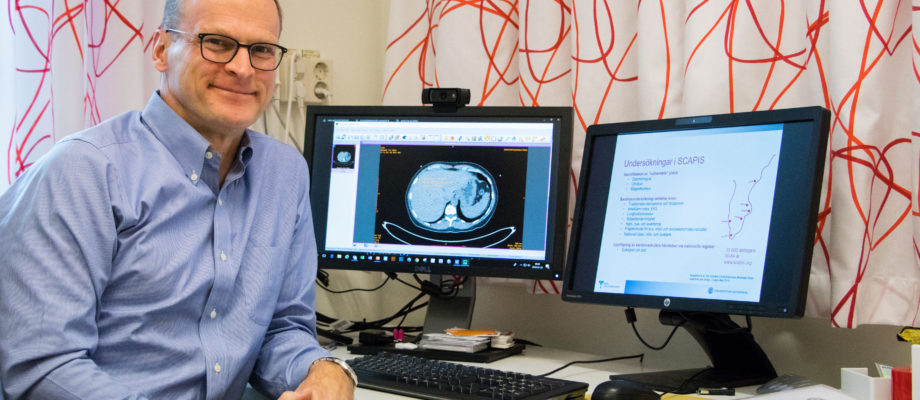ARTIFICIAL INTELLIGENCE. The unique research study known as SCAPIS will the starting point for one of the first Life Science projects to be implemented on the AI Innovation of Sweden collaboration platform. Several sub-projects are planned. As a first step, computers will learn to analyze cardiac images captured by computed tomography, or CT scans, and radiologists at Sahlgrenska University Hospital will evaluate the results.
AI Innovation of Sweden, recently inaugurated at Lindholmen Science Park, will become a leading new setting for collaboration on artificial intelligence. Vinnova is providing much of the funding, and the initiative involves more than 40 different partners, including Region Västra Götaland, Chalmers University of Technology and the University of Gothenburg. Life Science is one of four major research domains included in the initiative, and as its first pilot project, SCAPIS will lead the way for the projects that follow.
Complex volumes of data
Enormous amounts of data on 30,000 people have been collected within SCAPIS by six university hospitals in Sweden. Each of the participants in the study has been mapped with various tests and examinations and has answered numerous questions in surveys. Analyses of this material have begun and should help provide answers to why diseases such as stroke, chronic obstructive pulmonary disease, sudden cardiac arrest and heart attacks occur, why some people get them and others do not and how they can be prevented.

“Artificial intelligence gives us a new tool for managing such a large amount of data. With the power from the algorithms developed with machine learning, we can take into account many variables at the same time, which allows us to look at complex data sets in an entirely new way compared to more traditional statistical methods,” says Göran Bergström, a professor at Sahlgrenska Academy and chief physician at Sahlgrenska University Hospital. Bergström heads SCAPIS, the national research study being conducted with funding from the Swedish Heart-Lung Foundation.
Learning to analyze images of the heart
SCAPIS has identified three different sub-projects suitable for implementation within AI Innovation of Sweden. In the first project the algorithms will learn to analyze images of the heart captured by CT scans, in which the picture of vessels in the heart will have priority since no AI decision support for these exist anywhere in the world.
“It takes a trained radiologist an hour to analyze a cardiac CT scan. Our materials contain 30,000 images, so we can save a lot of time if AI can provide support in these analyses,” says George Bergström.
The project will develop a fully automated analysis tool. An AI model will be fed image information while it simultaneously receives answers about whether the heart pictured is healthy or if there are signs of pathological changes.
“The answers come from skilled radiologists at Sahlgrenska University Hospital who indicate in the images what is normal cardiac tissue, whether the image contains something that should be looked at more carefully or if it shows pathological changes,” Bergström explains. “Initially the radiologists will create 80 correct images, and then the programmers will run tests to see how well the algorithm has learned to analyze them. The radiologists will continue to feed the algorithm with correct image analyses until we are satisfied with the algorithm’s performance.”
Consistent analyses
The projects carried out within AI Innovation of Sweden will focus on future practical applications. When the algorithms have become capable of analyzing the images, they can be a good decision support tool for radiologists, and they will reduce the risk of mistakes.
“If you let 20 capable radiologists analyze the same images, they will to some degree make different assessments. The human capacity to analyze images is truly unique, but people are affected by fatigue, hunger or day-to-day circumstances. The trained network, on the other hand, always delivers the same result. With the support of AI, we will obtain faster and more consistent assessment of the images,” Bergström believes. He adds that radiologists can then focus on images that are more difficult to interpret, where the algorithm has failed.

Jan Kilhamn, head of health care and medical services R&D in Region Västra Götaland, also agrees that the project can improve the prevention, detection and treatment of cardiovascular disease.
He says, “We hope the expanded analysis now being done with AI on X-ray images of the heart can help identify at-risk patients more accurately and sooner and also provide guidance about the best treatment for specific patient groups.”
Cluster analysis and prediction
Researchers in SCAPIS plan two additional AI projects, but they will not be run on the AI Innovation of Sweden platform. One project concerns predicting illness and the other focuses on new diagnostics using cluster analyses. That project will result in a tool that can group different factors that distinguish people at risk of various diseases.
“We now divide diabetes into two types, type 1 and type 2. Researchers in Lund recently proposed instead that five different types of diabetes might be involved. This is a case where I think the data from SCAPIS using cluster analysis could help,” says Göran Bergström.
Predicting illness, also a primary objective of SCAPIS, involves being able to foretell who will become ill in the future. AI’s ability to weigh many variables without bias promises to improve the prediction models available today.
“Current risk models are rather poor. By adding omic data and combining it with new markers and image data, we can get a better picture of what groups require our intervention,” says Bergström
TEXT AND PHOTO: ELIN LINDSTRÖM CLAESSEN











